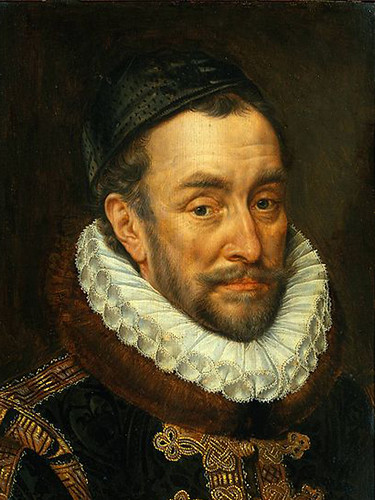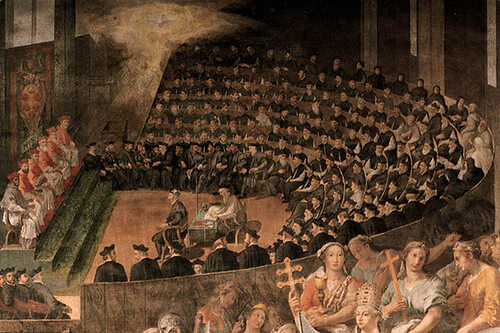17th century maritime expansion
The rise of the Dutch maritime commercial activities in the Pacific and Asia in the early 17th century is based on a series of events between the independent Netherlands merchant towns and King Philip II of Spain. The resistance of the Netherlands proved the undoing of Spanish dreams of a world empire.
A stubborn opposition to the Spanish Catholic overlords who controlled the Netherlands formed under William of Nassau, the Prince of Orange. William was a politique who favored political autonomy above theological doctrine, and because of this, was forced to live in exile in Germany. Philip enforced the edicts of the Council of Trent—internal criticisms and efforts at Catholic reform in reaction to Protestant success—upon the Netherlands, a historical turning point that cost the Spanish Crown countless lives and untold wealth. William emerged from exile and led the resistance movement against Philip.
The Council of Trent was a series of meetings of Catholic Church leaders that took place between 1545 and 1563 in response to the threat to Catholicism posed by the Protestant Reformation, which began in 1517. By the mid 16th century central Europe was divided between Protestant and Catholic Communities. Some rulers of small states adopted Protestant faiths as a way of building autonomous bases and breaking away from the Holy Roman Empire. Many conflicts emerged because of this. At the time, Protestantism was becoming popular in the Netherlands despite the fact that the Netherlands was a possession of Spain which was part of the pro-Catholic Habsburg Empire.
The 1560s was the beginning of a series of conflicts between Protestants in the Netherlands and Catholic authorities which would eventually end up in a declaration of independence of the northern provinces of the Netherlands in 1581, although fighting continued with the Spanish until 1593. During the 17th century, the (mostly Protestant Dutch merchants) surpassed the Portuguese (Catholics) as the dominate European power in the Indian Ocean and Island Southeast Asia.
Pacification of Ghent
By 1576, after a decade of persecution and warfare, the Dutch united internally. Known as the Pacification of Ghent, the 10 largely Catholic southern provinces and the seven Protestant northern provinces declared internal regional sovereignty over religious issues. The ensuing conflict wore down the Spanish who, by the 1580s, became preoccupied with other resistance movements in France and England. This allowed the Dutch to drive out all Spanish soldiers from the northern provinces by 1593 (the southern provinces made peace with Spain). Three years later, France and England formally recognized the independence of these northern provinces, but the formal peace between the northern Netherlands and Spain was not reached until the Treaty of Westphalia in 1648.
The Dutch new found independence permitted state sponsored expansionism into Asia and the Pacific with the ultimate goals of securing fabled spices and trading in China. The Dutch were also competing with the British, an upstart nation that defeated the Spanish Armada in 1588 under Elizabeth I, the last Tudor monarch.
England had made intermittent inroads into the Spanish Pacific through such privateers as Francis Drake, Woodes Rogers, and Thomas Cavendish; Drake was knighted for plundering Spanish ships and coastal towns. By 1600, the British had established the East India Company in India, a commercial outfit designed to conduct British trade throughout the Orient.
As a response to British commercial arrangements, two years later, in 1602, the Dutch set up their own East India Company in the Portuguese-controlled Moluccas (Indonesia) to exploit the spice trade. The Portuguese, once masters of the spice trade a century before, lacked the resources, manpower, and military wherewithal to counter the Dutch intrusion. “After 1609 … the Netherlands asserted its exclusive claim to the Moluccas and began an earnest campaign to squeeze out all competitors from the spice trade.
Visits to Guam
It was during the time of the formation of the Dutch East India Company that Dutch sailors stopped at Guam, according to the Spanish Jesuit historian Francisco Garcia. The first recorded instance occurred on 15-16 September 1600, when four ships commanded by Oliver van der Noort stopped at Guam, “bartering iron nails for provisions.” On 23-26 January 1616, Joris Spilbergen, who raided Spanish California coastal settlements, visited Guam on his successful circumnavigation, but little is known of his interaction with the CHamorus.
On 25 January 1625, the largest presence of Europeans visited Guam for three weeks. It was the Dutch Nassau Fleet—a flotilla of 11 ships and 1,260 men, plus 32 prisoners — under the command of Jacques L’Hermite (Witte Cornelisz de With served as navigator) that anchored off Humåtak’s coast. Scurvy had exacted a heavy toll on the sailors, but for the next 17 days, they recovered after bartering for copious quantities of rice, fruit, and coconuts. In addition, L’Hermite had to double plank the rotten timbers of the ships before returning to the Moluccas.
The Nassau Fleet departed Guam on 11 February 1625. It would mark the last visit paid by the Dutch at Guam.
For further reading
Beaglehole, JC. The Exploration of the Pacific. Redwood City: Stanford University Press, 1966.
Spate, OHK. The Spanish Lake: The Pacific Since Magellan. Vol. 1. Canberra: Australian National University Press, 1979.





